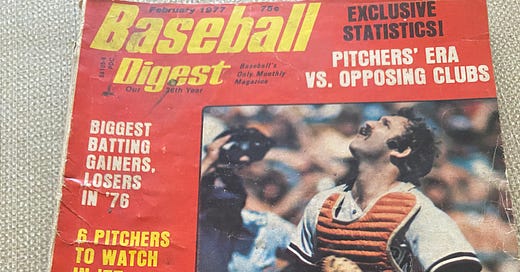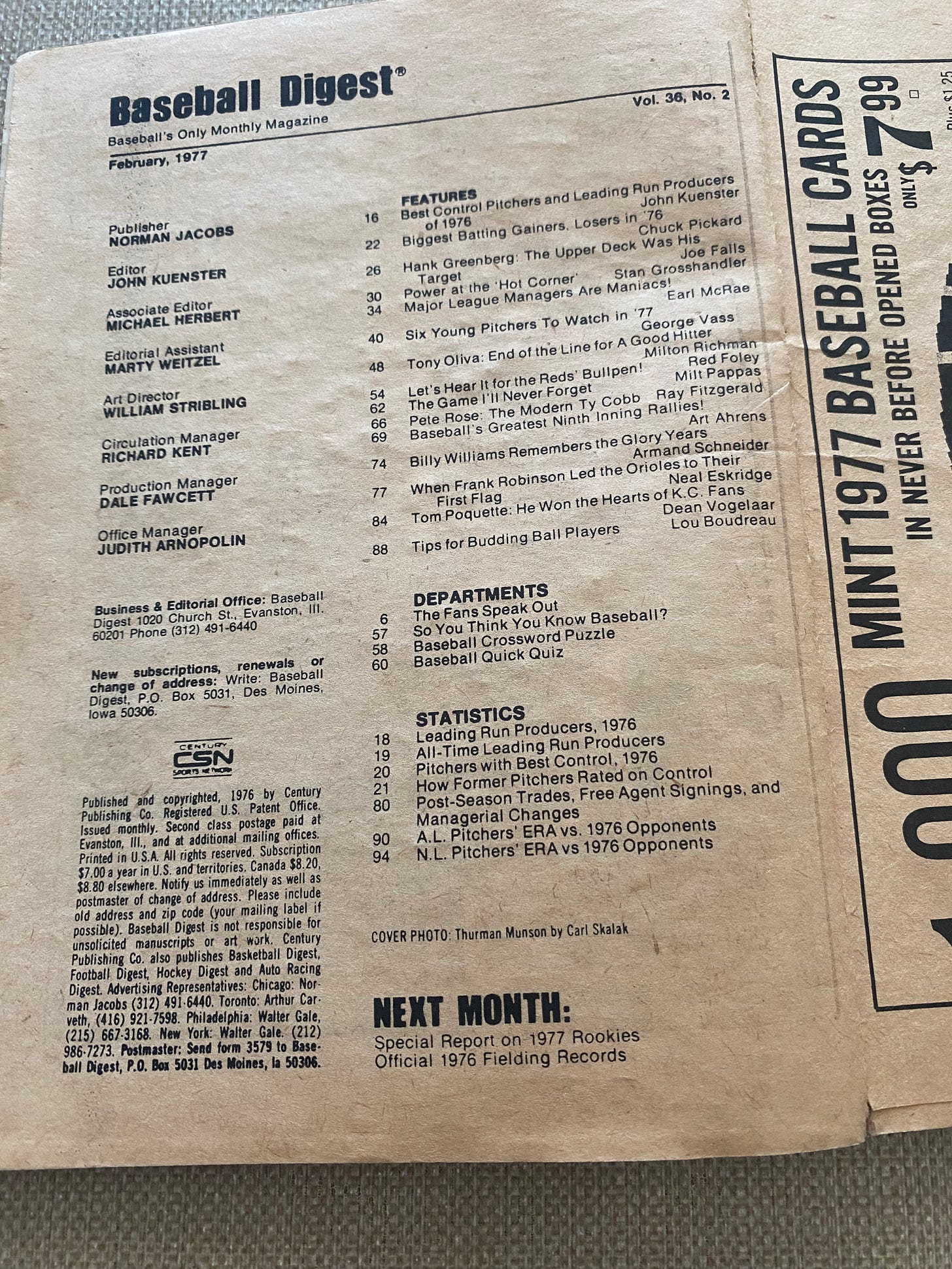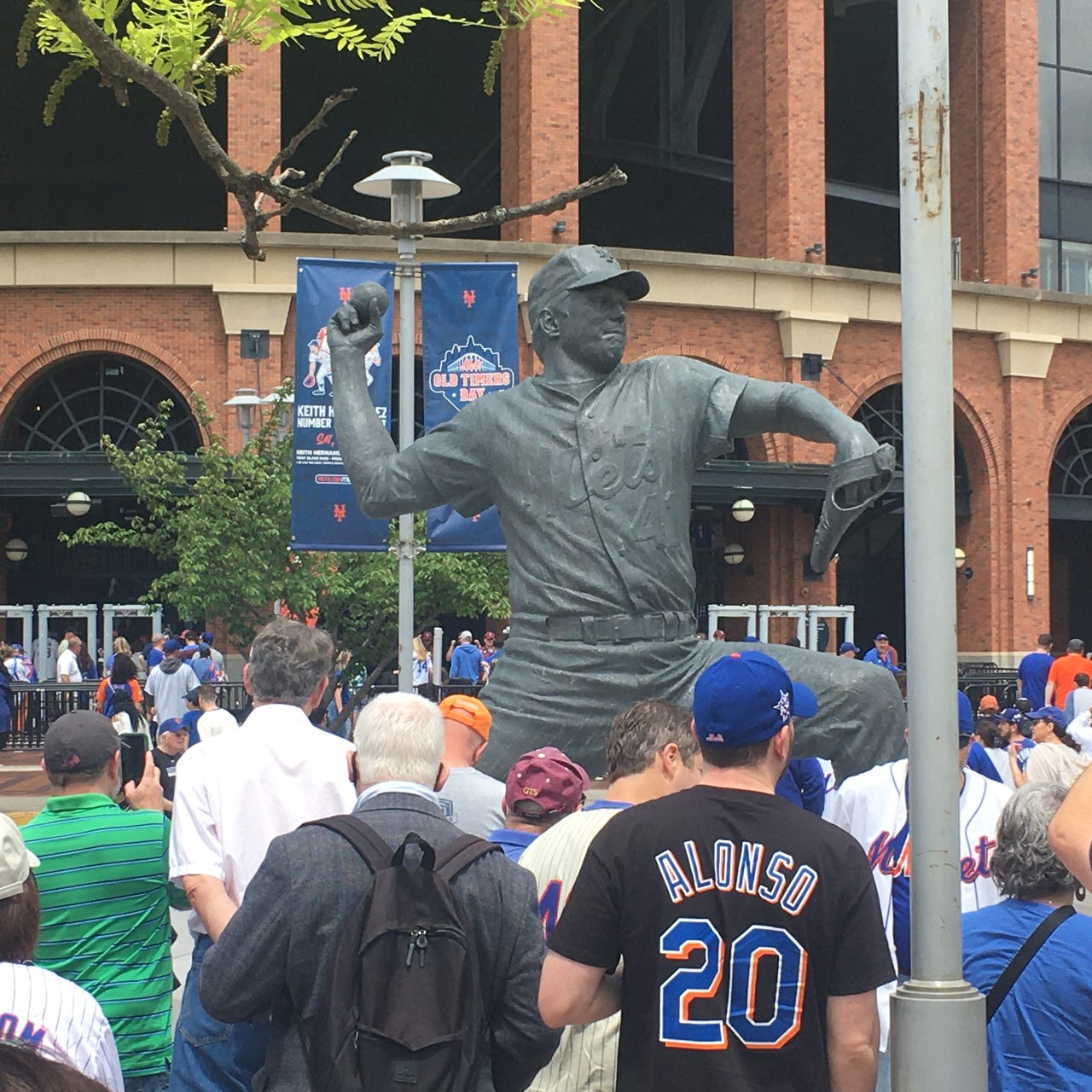February 1977
Before getting into the meat of this issue, I would like to discuss the cover. Thurman Munson is the cover subject, but as opposed to other issues that I have read, there is no Thurman Munson content to be found anywhere. (He is mentioned in the first question of this month’s quiz, but that doesn’t count.) Baseball Digest generally did not rely on placing big name/big market players on the cover to entice newsstand sales, so this is an unusual one. Munson was the reigning AL MVP, a fact which ultimately justifies his spot on the cover. It’s just that his spotlight without an accompanying article is uncharacteristic of the magazine.
1976/1977 was the first offseason with full free agency, and many of the old school gatekeepers of the game were not happy about this. Such as Baseball Digest editor John Kuenster. His opening column included all of the hysteria that you would expect. “The financial figures… have a way of depressing a guy who has to work a helluva lot harder for his money.” “A good deal of the romance and fun has gone out of the game with so much emphasis being placed on the business aspect of baseball.” Baseball is dying, guys.
In the 1976 season third basemen won the home run (Mike Schmidt and Graig Nettles) and batting titles (Bill Madlock and George Brett) in each league. That had never happened before; in fact at the time it was unusual for third basemen to lead their league in any of the triple crown categories. The list of names who had done so at that point includes some of the greats along with some guys whom you likely have never heard of.
Any issue is bound to include one of those article types that are in regular rotation, and this one contained yet another one which features an umpire discussing their, um, colorful interactions with managers. This time it is AL umpire Jim McKean. He doesn’t hold back. “They’re all maniacs… If Billy Martin did some of the things off the field that he does on, he’d be thrown in jail. Either that or in an insane asylum.” Tell us how you really feel, Jim.
Milt Pappas was a terrific pitcher who unfortunately had the stigma of being the guy who was traded for Frank Robinson. He had a bit of a chip on his shoulder - apparently he was NOT happy with the reference to that trade that was made in Bull Durham. This month he was the subject of the regular The Game I’ll Never Forget feature, and even there he couldn’t help but get a dig in. It was a no hitter that he threw in 1972; he had retired the first 26 hitters, but he walked the 27th hitter, spoiling his shot at perfection. He insists that one close pitch should have been called a strike. He did retire the next batter to preserve the no hitter, but he was clearly irritated about not getting the call he wanted on the previous batter.
Pete Rose: The Modern Ty Cobb. As of 1977 his career hit total was “only” 2,762, so there wasn’t yet much reason to believe that 36 year old Rose would approach, let alone pass, Cobb’s record. Rose himself mentioned here that his two primary goals were in the short term to pass Frankie Frisch for the most hits by a switch hitter and in the long term to pass Stan Musial for the most hits in the National League. The article points out that Rose is not the base stealer that Cobb was, but otherwise his approach to the game matched Cobb’s. Take that as you will.
Finally, the toughest thing to do is to predict future stardom for young pitchers. This month’s article chooses 6: Ray Burris, John Denny, Dennis Leonard, Rick Rhoden, Bill Travers, and Jim Umbarger. Of those 6 Leonard is the only one who truly became a star, and even in his case that stardom was short-lived before injury kicked in. Rhoden was pretty good, Denny had a couple of big seasons, Burris was a classic back end of the rotation guy. Travers didn’t amount to much and Umbarger never had a good year after 1976.
Most Memorable Moment - Arizona Diamondbacks
Quick reminder what this segment is all about: As part of the 100th anniversary celebration of the National League and the 75th anniversary of the American, in 1976 MLB named a most memorable moment for each franchise. I’m not sure what plans the league has in mind to celebrate next year’s sesquicentennial - other than setting the stage for a 2027 lockout - but this seems like a good time to revisit the original list, for three reasons.
There are 6 franchises that did not yet exist in 1976. In addition, 4 of the existing franchises were still so new that they didn’t have much history at the time. The Brewers’ most memorable moment, for example, was simply the return of baseball to Milwaukee. Finally, there have been plenty of significant events in the past 49 years, several of which have supplanted the original choices.
So, here goes. First, some housekeeping. The original 1976 list limited the choices to the current locations for each team, but I’m not sticking with that. Historically speaking it’s absurd to ignore moments such as the Shot Heard ‘Round the World or Jackie Robinson’s debut. Therefore, in instances such as those I will also add a moment from a team’s former home if needed. There is going to be a certain amount of recency bias in these choices, but part of that is due to accessibility. We can’t go to YouTube or MLB.com and find clips of the Homer In the Gloamin’ or of Bob Feller’s opening day no-hitter, so those moments are not as ingrained in our minds as the way that today’s selection is. I’m also going to try my best not to default into World Series moments, but let’s be honest. A great WS moment is memorable by definition. Let us begin with one of the easiest choices.
1976 winner: N/A
2025 winner: Luis Gonzalez’s scorching line drive
I am going to run through the franchises alphabetically, which means I am fortunate enough to start off with a no-brainer in Arizona. A walk off hit to win a World Series is memorable enough as it is, but when it comes from a franchise icon? Against the most decorated franchise in the sport’s history? Against the most untouchable postseason relief pitcher? Yeah, that’s memorable.
What was most stunning about the 9th inning of Game 7 of the 2001 World Series was how quickly things developed. Set against the post-9/11 backdrop, it was already one of the greatest World Series ever played up to that point, and Game 7 was a classic pitcher’s duel between Curt Schilling and Roger Clemens. It appeared that Alfonso Soriano had cemented himself as an all-time hero with a go ahead home run in the 8th. All that was left was for the mighty Mariano Rivera to get those last 3 outs in the 9th.
Shockingly, he failed to seal the deal, partially due to 2 uncharacteristic mistakes on his part: a throwing error and later on a hit batsman. That loaded the bases and brought Luis Gonzalez up to bat with the winning run on third and the infield drawn in. Tim McCarver astutely observed that this strategy could backfire. With Rivera’s penchant for drawing soft contact, he stated that there stood a good chance that Gonzalez could hit a soft liner which would land precisely where a fielder would be standing had he been playing at normal depth. Well, that’s exactly what happened. Gonzalez hit it where they ain’t, Jay Bell scored the winning run, and the Diamondbacks had their first, and to this day only, World Series title.
Statcast wasn’t yet a thing in 2001, so there is no accurate measurement of the exit velocity on Gonzalez’s hit. Better to believe that it was such a ferocious laser shot that it could not be measured by man. Whatever the speed it is enough to make it the most memorable moment in Diamondbacks history. Runner up would be Randy Johnson’s perfect game in 2004. Johnson’s pitch that accidentally pulverized a pigeon in 2001 spring training was NOT under consideration.
The Side Categories
Many of us mistakenly believed that the Hall was taking a new approach to country music with the inductions of Dolly Parton and Willie Nelson in consecutive years. The fact that no country artists have made it onto the ballot in the last 2 years demonstrates that it’s not that the Hall had the desire to induct more country acts. It’s that the Hall had the desire to induct Dolly and Willie. For the Hall to continue to acknowledge rock & roll’s country roots it will need to do so through side category inductions.
I have already mentioned that Kris Kristofferson is a likely inductee this year, but who else could be considered? One name that jumps out to me is The Carter Family, who were one of the foundational artists in the embryonic days of country music. Their Musical Influence bona fides are evident in the way that their tight family harmonies can be heard in acts such as the Everly Brothers. A potential Carter induction can also include the next generation of the family and bring June Carter Cash into the Hall. Patsy Cline could have been a reasonable inductee years ago in the artist category, but she would also be a solid Musical Influence candidate.
And of course I will not let my lobbying efforts for Emmylou Harris rest until she actually gets in. I gather that she has a tremendous amount of respect from other artists; I feel certain that if she were to ever be placed on the ballot that she would have an overwhelming amount of support from the voters. Since that hasn’t happened yet, she could easily be considered in a side category. She is one of the founders of what you can call either Americana or alt-country. She would be a great addition to the Hall and a very popular choice within the industry.
Any mention of Emmylou Harris also leads to Gram Parsons. In his brief career he helped write the proverbial rule book for country rock. Last year the Hall essentially did a buy one get one induction by honoring Alexis Korner and John Mayall in the same year. I could see them doing the same with a simultaneous Harris and Parsons induction.
All told there are generally around 6 or 7 people inducted through the side categories in any given year, so there are only so many available slots. Of the names I have mentioned today, I would most root for Emmylou Harris, at least partially because she is the only one who is still with us. She has tirelessly and passionately flown the flag for American roots music and deserves to be honored for that.
Empathy
There’s a (likely apocryphal) story that makes the rounds on occasion concerning Margaret Mead. The gist of it is that supposedly once while she was on a college lecture tour during the Q&A a student asked her what she considered to be the first sign of civilization. Rather than the expected answer such as development of a tool, her response was the discovery of the fossil of a healed femur. That’s because an animal in the wild with a broken limb could not possibly survive long enough for the bone to naturally heal. It couldn’t gather food or escape from prey. A healed bone, on the other hand, demonstrates that the tribe members found value in the individual; they took the time to care for another person.
Internet sleuths have found no evidence that this specific interaction with Mead ever happened or that she actually specifically said this, but even so the idea behind it is important. Concern for others is an important aspect of society, and the inability or unwillingness to place oneself in another person’s shoes has been one of the most destructive elements in contemporary life. It can be seen in everything from the demonization of the trans community to the leopard face eating meme. It’s OK to cast “others” aside, none of this will affect me, right? Oh, it will? I never saw that coming.
I have no idea what our country and our society will look like 1 year, 5 years, 10 years down the road. Over the course of a single day my personal balance of optimism vs. pessimism shifts multiple times. It’s crucial that we keep in mind the words of Mead (or the made-up Mead.) Everyone has a contribution to make to our commonwealth, discarding people for any reason diminishes us as a society.
DC Comics IP
I’m all about introducing new recurring features today. Here’s another one. I have mentioned that I used to be a serious comic book collector. I was a DC loyalist, which might come as a surprise because Marvel has generally been the “hipper” of the 2 major legacy comic publishers. DC characters tended to be interchangeable square-jawed paragons, whereas even though Marvel characters weren’t exactly complex, they at least had a bit more dimension than the DC ones. Marvel heroes had distinct personalities, as opposed to DC heroes, each of whom largely spoke and acted the same as each other.
But keep in mind that when I was a child comics were still marketed almost entirely to a kid audience. DC’s simplicity was ideal for a reader of my age. Plus, I found the melodrama in Marvel books too heavy handed. It felt to me like in every issue of a Marvel comic it was a requirement that at some point a character needed to declare “this is the deadliest menace we have ever faced!” DC finally started to get more ambitious at the precise time that I would have normally aged out of reading comics. The books matured at the same rate that I did, even more so when they introduced the Vertigo line of books.
Which is all to say that when the MCU became such a dominant force I looked it with a combo of pride and envy. Pride because my generation of nerds, I term which I use affectionately, now served as creative forces in the industry and treated the material with respect rather than condescension. My fellow geeks won. Envy because I so wished that it could have been DC instead. The quality of DC’s filmed output was all too erratic. Marvel properties did not produce a movie as good as The Dark Knight, but on the other hand DC had a significantly higher number of utter failures.
That should not have been the case. Like Marvel, DC has some of the most iconic characters in American fiction. Like Marvel, DC has a strong bench of existing characters that have thrived over the course of decades. Unlike Marvel, the DC movie universe has failed to find a consistent approach. I have a lot of hope and faith in James Gunn; I also hope it’s not too late. Marvel’s dominance has waned; it remains to be seen if that is due to superhero fatigue or if is simply due to the fact that the MCU is in a creative rut.
What I am going to do is take a look at some of my favorite series that DC has published along with any movie or TV adaptations that have been made from those properties. There have been some that were successfully adapted, others whose adaptations were subpar, and others that still only live on the printed page. I’ll largely steer away from the DC Big 3, you don’t need me to tell you about this Batman guy. Stay tuned.
One note about this; comic book adaptations can be tricky. Print and visual are two entirely different media. Dialogue and character names can sound a lot sillier when read aloud by actors - think of how cringy the phrase “mother box” sounded in the Justice League movie. Also, some of the more brightly colored costumes look a little too garish on the screen. Then of course there is the depiction of women. True, male characters in comics have implausible physiques as well. There is a difference, however, between a man with 8-pack abs and a woman who is 6 feet tall with D-cups, a 24 inch waist, and a scantily clad costume. That makes it a challenge to do a straight translation. (When there was brief discussion on turning Justice League Dark into a TV series, every horny guy on the internet was speculating on which actress could portray Zatanna.)
Closing Laughs
That should be enough for today. Thanks for making it this far, have an enjoyable day everyone. See ya on Wednesday.








Right there with you about the Hall and potential country inductees. That the Carter Family (and Lonnie Donegan) aren't in shows they don't really understand the story they say they're trying to tell -- or don't care. Or both.